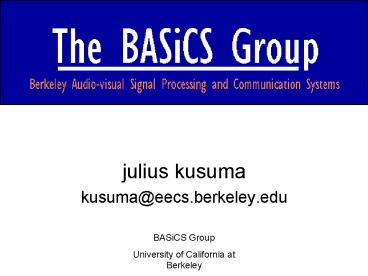BASiCS Group PowerPoint PPT Presentation
1 / 28
Title: BASiCS Group
1
- julius kusuma
- kusuma_at_eecs.berkeley.edu
2
DONT SHOOT THE MESSENGER!
3
Outline
- Introduction
- Multimedia communication
- Distributed coding
- Applications
4
Outline
- Introduction
- Multimedia communication
- Distributed coding
- Applications
5
BASiCS in a Nutshell
Sandeep Pradhan pradhan5_at_eecs.berkeley.edu
Jim Chou jimchou_at_eecs.berkeley.edu
- Prof. Kannan
- Ramchandran
Rohit Puri rpuri_at_eecs.berkeley.edu
Anand Raghavan anand_at_eecs.berkeley.edu
Julius Kusuma kusuma_at_eecs.berkeley.edu
6
Outline
- Introduction
- Multimedia communication
- Distributed coding
- Applications
7
Multimedia Communication
- Need to communicate over time-varying channel
conditions - Multimedia data is inherently soft
- can be tuned to available resources
- the amount of resources available, such as
storage delay. - naturally admits a multiresolution (MR)
representation
8
Desirable Attributes
- Adaptivity and robustness to BOTH source and
channel characteristics - End-to-end expected quality as performance
measure - Graceful degradation with respect to channel
impairments - Philosophy Use a multiresolution framework
- Optimally tune the resolution knob
- Flexible architecture
- Applicable to many communication scenarios
9
MR Source Coding
- wavelet coarse-gtfine picture
progressive information stream
10
MR JSCC Basic Idea
- Use MR source decomposition (e.g. using
wavelets) - Use MR channel coding (UEP coding)
- Optimally match MR source coder to MR channel
coder
Protect more important information better!
11
MR JSCC Block Diagram
STRONG RECEIVER
Channel capacity C2ltC1
fine
C1
coarse
TRANSMITTER
fine
coarse
WEAK RECEIVER
C2
coarse
12
UEP in Modulation Domain
More efficient than conventional TDM/FDM
strategy (embedded transmission, inspired by
Covers broadcast channel)
13
MD Coding Illustrative Example
- Multiple Description
- decomposition into streams w/ some fidelity
- allow joint decoding to improve fidelity
the quick brown fox jumps over the lazy dog
th qu ck bro n fo j m s er th l z
d
e ic b wn f x ju p ov r he la
y og
e ic b wn f x ju p ov r he la
y og
14
Multiple-Description (MD) coding
X
- Multiple levels of quality delivered to the
destination - Quality(X0) gt Quality(X1), Quality(X2)
15
Joint Source-Network Coding
- Consider network as an erasure channel.
- In a non-priority network all packets have equal
probability of getting dropped. - Use channel coding to transform bitstream into an
optimally robust one
16
UEP for Packet-switched Networks
- Packetization strategy for MR bitstream
- Graceful degradation
- Does not require priority routing
progressive bitstream
information bits
parity bits
17
Multicast Application
18
Outline
- Introduction
- Multimedia communication
- Distributed coding
- Applications
19
Source Coding with Side Information at Receiver
(binary illustration)
- Let X and Y be length-3 binary data (equally
likely), with the correlation Hamming distance
between X and Y is at most 1. - Example When X0 1 0,
- Y can equally likely be 0 1 0, 0 1 1, 0 0
0, 1 1 0.
20
- What is the best that one can do?
- The answer is still 2 bits!
How?
21
- The Encoder sends the index of the coset
containing X.
- The Decoder with this information and the
knowledge of Y, reconstructs X without error.
- Note
- Coset-1 is a repetition code.
- Each coset has a unique syndrome associated
with it
22
Cosets and Syndromes
X 0 1 0
23
Outline
- Introduction
- Multimedia communication
- Distributed coding
- Applications
24
Application Sensor Network System
Joint Decoding
Scene
Channels are bandwidth or rate-constrained
25
Problem Statement Encoding of Correlated
Observations
- Group-theoretic construction of generalized coset
codes can be done for symmetric encoding - Performance matches that of asymmetric encoding
- Encompasses trellis codes and lattice codes
- Interesting interplay between source coding,
channel coding and estimation theory
26
Application Signal enhancement with side
information
- Upgrading NTSC to HDTV with a digital
side-channel (Shamai Verdu '98)
Noise
Analog
Digital Encoder
Decoder
Digital
27
Testbed Plan
- Multimedia wireless testbed
- Bunnycam
Cowcam
28
(No Transcript)

